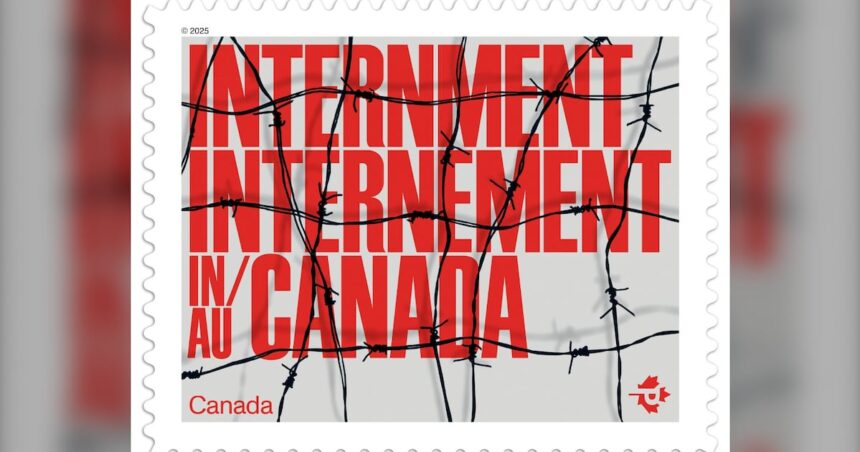The small postage stamp—just a 35 mm square—bears a startling image: a family of four silhouetted against barbed wire fencing. In this deceptively simple design, Canada Post has crystallized one of the nation’s most painful histories, one that many Canadians have never learned about.
Last week, I stood in a sunlit meeting room at Canada Post headquarters in Ottawa as the Crown corporation unveiled its 2025 commemorative stamp recognizing the internment operations that affected thousands of civilians in Canada during the First World War. Between 1914 and 1920, more than 8,500 people were forcibly relocated to 24 internment camps across the country, including the Interior of British Columbia and remote areas of Northern Ontario.
“This stamp represents the acknowledgment of a dark chapter many Canadians know nothing about,” says Lubomyr Luciuk, who joined me at the unveiling. As a founding member of the Ukrainian Canadian Civil Liberties Association, Luciuk has spent over three decades advocating for recognition of internment operations. “My own grandfather narrowly avoided internment by fleeing to the United States.”
The majority of internees were Ukrainian immigrants who had been invited to Canada with promises of freedom and prosperity, only to be labeled “enemy aliens” when war broke out. But the camps also held Germans, Austrians, Hungarians, Poles, Croatians, Serbians, and others from the Austro-Hungarian, German, and Ottoman Empires.
At Castle Mountain in Banff National Park, internees were forced to build roads and clear land in harsh conditions. In Spirit Lake, Quebec (now La Ferme), families were separated, with men performing hard labor while women and children lived in crowded quarters. Many internees lost their jobs, property, and savings during their confinement.
“My mother was just six when her father was taken,” says Mary Manko Haskett, now 97, whom I interviewed by phone from her Montreal home. Her father was interned at Spirit Lake for two years. “My younger sister died there. She was just two and a half.”
The stories of survivors like Haskett’s family might have been forgotten entirely if not for the Ukrainian Canadian community’s persistent advocacy. In 2008, the Canadian government established the Canadian First World War Internment Recognition Fund with a $10 million endowment to support education and commemoration projects. The stamp’s release follows years of work by the Fund and community organizations.
Canada Post partnered with the Fund to develop the stamp, which features artwork by Toronto-based illustrator Jori Bolton. “We wanted to capture both the institutional nature of internment and its human cost,” Bolton explains. “The family silhouette against barbed wire creates that tension.”
The stamp design is particularly significant as it will travel across Canada and internationally, carrying this history to mailboxes and collections worldwide. According to Canada Post data, commemorative stamps reach approximately 2.5 million collectors globally, serving as tiny ambassadors of Canadian history.
Dr. Kassandra Luciw, a historian at the University of Alberta who specializes in Ukrainian Canadian history, notes that the stamp’s significance extends beyond acknowledgment of past wrongs. “This is about recognizing patterns that can repeat,” she tells me as we examine the stamp design together. “Canada’s internment operations created a template that was later used for Japanese Canadian internment during the Second World War.”
Indeed, between 1942 and 1949, approximately 22,000 Japanese Canadians were forcibly relocated, many to the very same facilities that had held European internees decades earlier. This historical echo makes the stamp’s message even more resonant.
The timing of the stamp’s announcement—during heightened global tensions and migration crises—feels particularly relevant. Statistics Canada reports that Canada welcomed over 437,000 permanent residents in 2022, many fleeing conflict zones. The lessons of internment operations speak directly to how nations treat vulnerable populations during times of fear and uncertainty.
“What happened to these internees wasn’t an accident or wartime necessity,” explains James Karas, executive director of the Canadian Museum of Immigration at Pier 21 in Halifax. “It was a policy decision based on xenophobia and economic opportunism disguised as national security.”
Documents in Library and Archives Canada reveal that many internees were used as forced labor on infrastructure projects, including the development of Banff National Park. Their unpaid work created an estimated $25 million in value (in today’s dollars) for the Canadian government.
For descendants of internees, the stamp represents a long-overdue acknowledgment. “My grandfather never spoke about his time at Kapuskasing camp,” says Stefan Petelycky, whose grandfather was interned for nearly two years. “This stamp helps validate the suffering he could never put into words.”
When the stamp enters circulation in April 2025, it will coincide with the 100th anniversary of the closure of the last internment facility. Schools across Canada will receive educational materials about internment history as part of the commemorative program.
As I left the unveiling ceremony, I noticed a small display case containing artifacts from the camps: a rusted mess tin, a fragment of barbed wire, a tattered identification card. These objects, like the stamp itself, serve as physical reminders of historical injustice.
In our era of digital communication, physical mail may seem increasingly obsolete. Yet there’s something powerful about a stamp’s ability to slip into everyday life, to travel from hand to hand, carrying not just letters but also difficult truths about our shared history.






